ABSTRACT
To enhance integrated rainwater management in crop-livestock systems in the Volta basin of Burkina Faso, innovation platforms (IP) comprising of multiple stakeholders were established in the districts of Koubri and Ouahigouya. Quarterly IP meetings were organized to collectively identify and prioritize constraints and opportunities, and to design and implement strategies to address them. IP represents an example of putting the agricultural innovations systems’ perspective into practice. Several studies have evaluated the performance of IPs, but these are often based on external (mainly qualitative) assessments during mid-term and/or end evaluation. In this study we are interested in how key processes develop over time and how this is perceived by participants themselves, since this determines the participation and commitment of stakeholders and hence the success of the IP. To ensure adequate documentation of IP processes and activities, several monitoring and evaluation tools were developed. This paper focuses on the assessment of the IP performance in terms of consistency of participation across meetings and stakeholder groups, relevance of identified issues, information exchange, conflict resolution, participation in decision making, facilitation, and perceived benefits. For all the indicators used to assess the IP, the mean scores tended to increase with the lifespan of the IPs. This reaffirms that the IP is perceived as valuable by its members as a way to enhance agricultural development. At the same time though an IP is not a “quick-win”, but takes time to mature for it to become fully functional and achieve desired outcomes.
Key words: Agricultural development, innovation systems, crop-livestock systems, social learning, Volta basin.
There is a general consensus that a linear approach to agricultural research and development, has had limited success in sub-Saharan Africa (Leeuwis and van de Ban, 2004; Adekunle et al., 2012; Hounkonnou et al., 2012). For example, many technologies have been generated through agricultural research in sub-Saharan Africa and transferred by extension workers to farmers, but their adoption and impact on productivity and livelihoods of rural households
have been sub-optimal (Adekunle et al., 2012). In their review on intensification of farming systems in sub-Saharan Africa, Pretty et al. (2011) rightly observed that productivity increases though improved technologies does not necessarily translate into improvement in livelihood of the rural poor without proper consideration of socio-economic, policy and institutional contexts (Hounkonnou et al., 2012). Therefore, to enhance technology uptake and sustainable intensifi-cation of agricultural systems, it is essential to include all relevant stakeholders in the process of agricultural innovation.
To address agricultural innovation through participation of multiple stakeholders, the Forum for Agricultural Research in Africa (FARA) has promoted the Integrated Agricultural Research for Development (IAR4D) approach based on an innovation systems framework (Adekunle et al., 2012). The agricultural innovation systems’ framework emphasizes the collective nature of innovation and stresses that innovation is a co-evolutionary process, resulting from alignment of technical, social, institutional and organizational dimensions (Lundvall, 2011). Increasingly, the innovation systems framework is also applied to commodity value chains, which can be seen as systems comprising different types of actors in which knowledge and/or research products with purchased and farm- or household-provided inputs are used and developed in natural resource based production, and are marketed and processed for sale or consumed (Adekunle et al., 2012; Van Rooyen and Homann-Kee Tui, 2009).
Operationalization of the IAR4D approach is often through a multi-stakeholder platform referred to as innovation platform (IP). In the context of commodity value chains, the IP
[1] is a dynamic and fluid assembly of actors along the chain to support action learning, and actors’ linkages, provide opportunities to generate innovation, and strategies for scaling up and out (Pali and Swaans, 2013). An IP facilitates research and learning that not only generates new knowledge, products or technologies, but also ensures the use of research products (Adekunle et al., 2012). Generally, an IP is a mechanism to enhance communication and innovation capacity among mutually dependent actors, by improving interactions, coordination, and coherence among all actors to facilitate learning and contribute to production and use of knowledge (Pali and Swaans, 2013).
The Integrated Agricultural Research for Development (IAR4D) approach is central to the design, testing and evaluation of agricultural technologies and for scaling up and out of promising technologies as it enhances the engagement of relevant stakeholders in participatory action research (Adekunle et al., 2012). The necessity of engaging other stakeholders apart from researchers is driven by the realization that innovation does not arise only from a simple process of transferring knowledge from research to end-users but necessitates a process of interaction and learning from diverse sources whereby the agricultural research organizations are part of a much larger constellation of knowledge producers. The emphasis of the collective nature of innovation is the core of the agricultural innovation systems framework (Lundvall, 2011; Hounkonnou et al., 2012; Kilelu et al., 2013; Schut et al., 2015). The innovation systems framework stresses that innovation occurs through the collective interplay among many actors including farmers, researchers, extension officers, service providers and development organizations. It has to be emphasized that innovations are not just about technology but also include social and institutional change (Leeuwis and van de Ban, 2004).
One of the challenges of IP is systematic monitoring and evaluation (M&E) of its key processes and outcomes (Klerkx et al., 2012). To address this challenge, a host of approaches have been developed to monitor and evaluate the activities of IPs using both quantitative and qualitative methods (Pali and Swaans, 2013; Cadilhon, 2013). Unlike result-oriented monitoring and evaluation (M&E) which is often applied in evaluating results against pre-defined objectives and indicators, the approach to monitor and evaluate IP activities should be more flexible, participatory, and reflexive as IPs interact and affect the environment within which they operate. In this study, we applied a reflexive monitoring approach, using broadly defined qualitative and quantitative parameters based on the IP literature to assess the performance of two IPs in Burkina Faso. Table 1 provides information on key parameters, tools, and indicators.
The CPWF Volta Basin Development challenge project on integrated management of rainwater in crop-livestock systems, took an overarching IAR4D approach and established IPs that brought together relevant stakeholders to come to more effective and sustainable water management practices, leading to improved Value Chain (VC) performance and farmer livelihoods. While the inclusion of relevant stakeholders in agricultural research for development is not questioned, there has been discussion to what extent IPs are useful and effective in boosting African agriculture. Several studies have tried to shed more light on the performance of IPs by studying and revealing key processes and outcomes, but these studies are often based on external (mainly qualitative) assessments during mid-term and end of project evaluation (Schut et al., 2015; Swaans et al., 2014; Adekunle et al., 2012). For the purpose of this study, we were more interested in tracking the development of IP processes over time and how these are perceived by participants themselves, since this may explain participation and commitment of stakeholders and eventually the success of the IP. The objective of this paper is therefore to assess the performance of the IP in terms of its key processes in two project sites in Burkina Faso over time based on stakeholders’ own views.
In this paper, an IP is sometimes referred to as multi-stakeholder platform. Other authors have referred to IPs as “innovation configurations” (Engel 1995), “innovation networks (Klerkx et al. 2012) and “learning alliances” (Boogaard et al. 2013; Cullen et al. 2014).
The study sites included Ouahigouya and Koubri districts in the Volta basin of Burkina Faso (Table 2). Crop-livestock systems dominate the farming systems in the study sites. Agricultural activities are heavily dependent on rainfall, which accounted for the sources of livelihood of more than 80% of the populations (Douxchamps et al., 2014). The dominant crops cultivated in the study areas were maize, sorghum, millet, cowpea and groundnut. Rice is often cultivated in the floodplain and around the small reservoirs. Koubri has a very good market access as it is very close to Ouagadougou, the capital of Burkina Faso. In each district, four communities were selected for the project activities on integrated management of rainwater in crop-livestock systems. Based on the findings from participatory rural appraisal and value chains analysis, key actors along crop-livestock value chains were identified and brought together to set up four innovation platforms (two in each district) involving stakeholders from the project communities in July 2011. However, the number of IPs was later reduced to two due to overlap in stakeholders involved and for better facilitation of the IPs. At the participatory rapid appraisal in each community, the farmers and livestock keepers were asked to select 2 to 4 focal persons to participate at the IP including at least a woman. Other actor’s groups (trader, processor, technical services, researchers, development agencies, and credit agency) in the IP also nominated between 2 and 4 focal persons to participate at the quarterly IP meeting. These focal persons were charged with responsibility of providing feedbacks from the meetings to their members as well as lead the implementation of IP activities agreed at the meetings.
At the first IP meeting, opportunities and constraints to rainwater management in crop-livestock systems from the baseline studies conducted by the project were discussed and prioritized as well as strategies to improve identified crop and livestock value chains. The promising value chains identified from the value chain analysis by the project were discussed at the IP meeting and prioritized for crops and livestock although the IPs initially had a strong production focus and only at a later stage focused more on market access. The prioritized value chains were sorghum, maize, and cowpea for crops while sheep and goat value chains were selected for livestock. Key actors that participated at the inception IP meeting included farmers (both male and female), traders, livestock keepers, input suppliers, technical agents, researchers, and non-governmental organizations involved in microcredit. Subsequent IP meetings held quarterly focused on different issues jointly identified by the facilitators and IP members which included soil and water conservation techniques, access to credit, access to technical services, training in marketing of agricultural produce, and monitoring and evaluation of IP processes and outcomes.

To ensure adequate documentation of IP processes and activities, and for evaluation of the performance of the IPs, monitoring and evaluation tools were developed comprising of register of actors, IP meeting and activity report, and members’ assessment of the IP. These monitoring and evaluation tools were administered at each IP meeting by an enumerator who was proficient in the local language of the IP members starting from 6 months after the establishment of the IP in Koubri and Ouahigouya till the last meeting before project end (March 2012 up till June 2013). The key issues discussed at the IP meetings and the resulting activities carried out before the next IP meeting are presented in Table 3a and b.
To assess the functioning of both IPs in terms of activities carried out, processes and outputs, a semi-structured questionnaire was administered at the end of every IP meeting from March 2012 to June 2013. Members representing the actors’ groups at the IP were asked to score individually the IP functioning on a scale of 1 (minimum) to 5 (maximum) on a number of parameters for analyzing IP performance. The parameters included understanding and relevance of the IP goals and issues addressed, extent of participation in decision making at the IP, extent of information flow and sharing among the actors, conflict resolution within the IP, facilitation of IPs, and perceived benefits of IP activities and achievement of the IP goals. To elaborate on the IP members’ perception on the benefits of their participation at the meetings, we asked two types of producers (crop farmers (crop-dominated livelihood strategy) and livestock keepers (livestock-dominated livelihood strategy, mainly agro-pastoralists) at the last IP meeting of June 2013 on what they perceived as gains on a scale of 0 (none) to 10 (highly satisfactory) based on the criteria determined by the project team. Data collected included gender of the participants and their groups along the value chains namely producer, trader, processor, credit agency, technical service, researcher and development practitioner (mainly NGO).
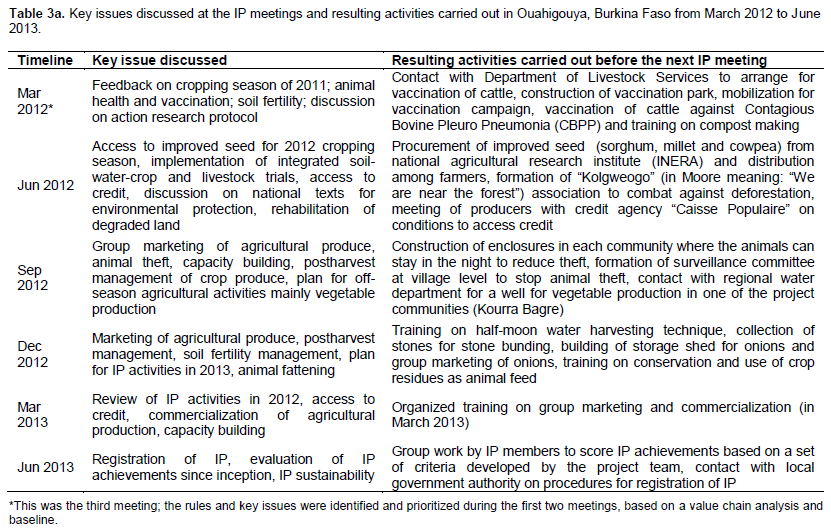
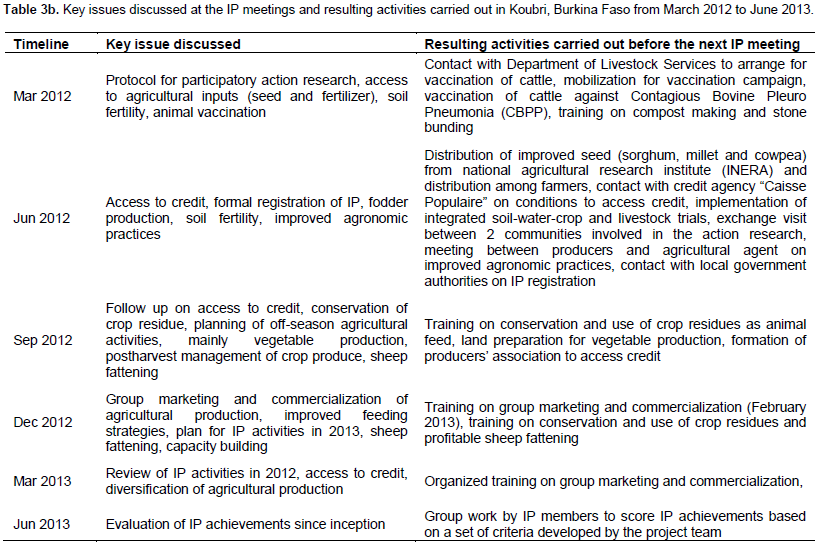
The IP meetings were facilitated by the Netherlands Development Organization (SNV, Burkina Faso) and Fédération Nationale des Groupements Naam (FNGN, a local NGO in Burkina Faso), with backstopping from the International Livestock Research Institute (ILRI). SNV and FNGN had extended and strong experience in facilitation of multi-stakeholder platforms, and were selected to facilitate the IPs to avoid domination by research organizations (Boogaard et al., 2013).
Data analysis was performed with SAS (Statistical Analysis System Institute, 1987) using the Means Procedures for summary statistics and General Linear Model (GLM) procedures for variance and regression analyses for the data on members’ assessment of IP functioning. For analysis of variance and regression model, response (dependent) variables were the six indicators of IP performance namely understanding and relevance of issues addressed by the IP, participation in decision making, information flow and sharing among actors, conflict resolution, quality of facilitation of IP and perceived benefit of IP. The independent variables were IP location (Koubri and Ouahigouya), period of IP meeting, actors’ group and gender. For the regression analysis, the independent variables were considered as binary categorical variables with value of either 0 or 1. Unless otherwise specified, the level of significance was declared at p < 0.05.
The assessment of IP performance is described and discussed in three parts: Participation of stakeholders and key issues identified the perception of key processes and benefits by stakeholders, and achievements as perceived by crop and livestock farmers.
Participation and major activities carried out by the innovation platforms
The number of participants at the IP meetings from March 2012 to June 2013 varied from 24 to 35 in Ouahigouya and from 30 to 42 in Koubri (Figure 1). The highest attendance was recorded in Koubri directly following the training on commercialization and marketing of agricultural produce in February 2013 which attracted many actors (including farmers, State technical agents and development practitioners) (March, 2013). Given the diversity of IP actors, stakeholders are only likely to participate in IP meetings when there are issues of shared or common interest (Boogaard et al., 2013). As a result of domination of farmers in the IPs in the two study sites, production issues tended to dominate the agenda as shown in Table 3a and b but these issues often complied well with the mandate or objectives of other stakeholders in the IP. Though production issues are the most obvious and priority constraint; however, more emphasis was paid later to inputs, markets, and even the continuation of the IP as a platform (e.g. through registration). Besides, the results indicated that capacity building activities, especially those that can lead to generation of revenue –were of common interest to most actors in the IP.
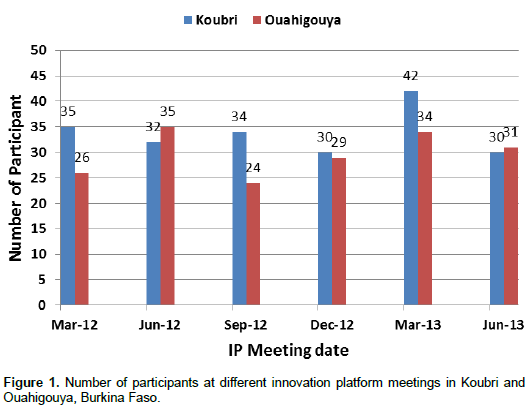
The results agree with observations by Nederlof et al. (2011) that IP members are motivated to participate when benefits are clear. The lowest attendance observed in Ouahigouya coincided with the peak of cropping season when demand for labor is high for weeding and other farm activities although similar trend was not observed in Koubri. These results suggest that timing of IP meetings will affect attendance and level of participation particularly when more participants are from a single actor category e.g. producers (farmers) in this case (Nederlof et al., 2011; Boogaard et al., 2013). There tended to be more participants at the IP meetings in Koubri than in Ouahigouya, which could be partly attributed to the proximity of the communities to the IP meeting venue. In terms of gender of the participants, men accounted for at least 60% of the total participants (Figure 2a and b) in both locations. The proportion of women at the IP meetings in Ouahigouya tended to be slightly higher than in Koubri. The number of women at the meetings declined after the IP meeting of March 2012 and then picked up as from March 2013. The domination of men at the IP meetings could be attributed to cultural factors (Amankwah et al., 2012) as well as pertinence of the issues addressed at the meetings to women These results suggest that the design and planning of participatory approaches such as IPs may need to be adapted to the local context to ensure inclusion, and not exclusion, of marginalized groups, that is, women in this case.
In terms of actors’ group, the producers accounted for between 30 and 65% of the total participants at the IP meetings in both locations (Figure 3a and b). The actors’ group consistently represented at the IP meetings were the producer (crop and livestock smallholder farmers), trader, processor, technical service, researcher and development practitioner (mainly NGOs). The credit agency was only present in one IP meeting (March 2013) in Koubri when the main issue discussed at the meeting was on commercialization and marketing of agricultural produce. The credit agency was consistently present at the IP meetings in Ouahigouya. The development practitioners (NGOs such as SNV and FNGN), traders, and researchers were consistently present at all the IP meetings (Figure 3a and b). The participation of the technical services, mainly from department of agriculture in the local district tended to fluctuate. In Ouahigouya, the presence of the technical service declined in the last two meetings (March and June 2013) probably due to dwindling interest. From experience, participation of this actor group is often based on direct benefits, for example payment of per diems or sitting allowances which should be discouraged as it is not sustainable for the IPs (Nederlof et al., 2011).
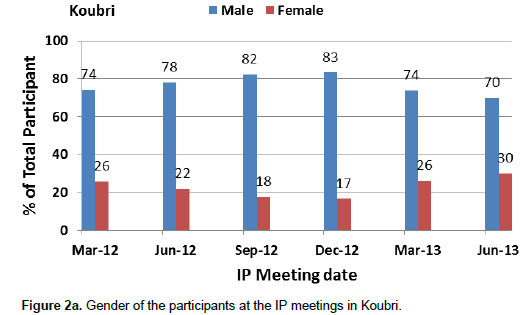
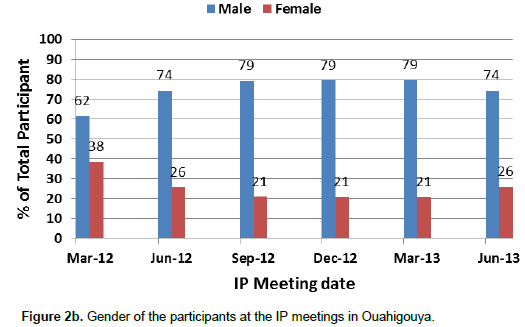
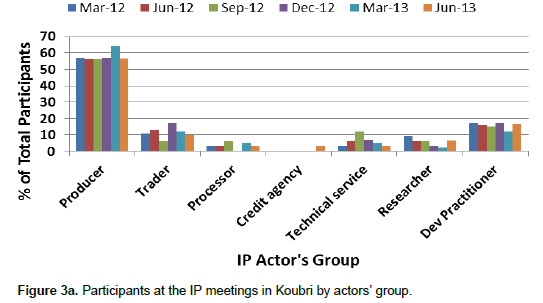
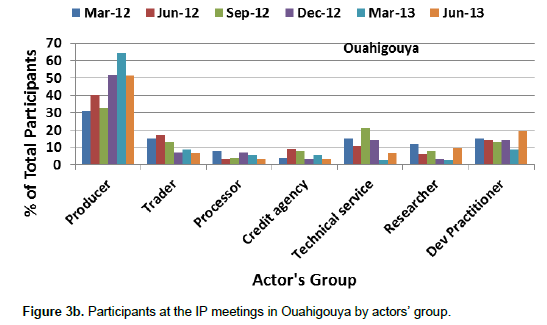
Major activities identified and carried out by the IP in Koubri and Ouahigouya included training, soil and water conservation initiatives, linkages to financial and technical services for technical information on agricultural production practices and access to credit, supply of agricultural inputs, group marketing (particularly of onion), animal management and post-harvest management (Figure 4). Activities such as group marketing of onions, animal management - particularly vaccination of cattle against Contagious Bovine Pleuro Pneumonia (CBPP) through contact with technical services, and capacity building, were some activities that the farmers’ associations in the communities could not achieve before the establishment of the IP. The diversity in reported activities indicate that at the local level, IPs tend to focus on improving agricultural practices through joint experimentation and by linking farmers to markets and other stakeholders (Nederlof et al., 2011).
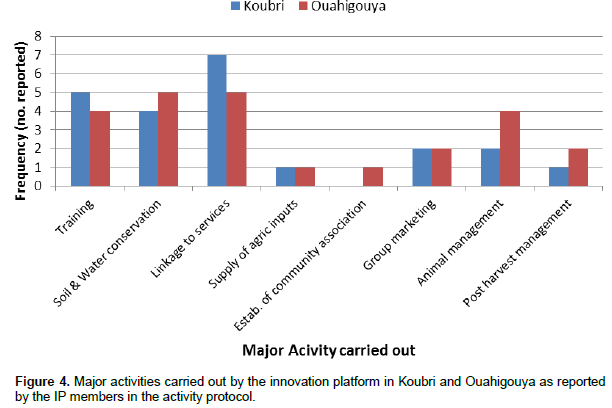
Training of the IP members was on commercialization and marketing of agricultural produce, soil and water conservation techniques (stone bunding, zai and composting). In addition, there was training on conservation and use of crop residues for profitable sheep fattening in Koubri. Soil and water conservation activities carried out by the IP members in both locations included stone bunding, digging well and composting. Though these activities are not new to the IP members, the innovative aspect was the collective implementation of these activities by members from different communities and the involvement of the technical agents providing necessary advisory services. This essentially entailed linking producers to technical services (agricultural, livestock and environmental services) for information on agricultural production practices such as improved soil fertility management techniques, crop pests control, diagnosis of animal diseases and to financial services (credit agency such as “Caisse Populaire”) for information on access to credit. The linkages were often facilitated by FNGN and SNV. In the interactions between the producers and credit agency, the conditions of access to loan were explained to the farmers even though the feedback from the producers was that the conditions are difficult to meet, particularly the need for collateral to obtain loan. Activities under animal management included construction of corralling pen and park for the animals to prevent damage to crops in the cropping season and to minimize theft. Post-harvest management of crop included storage of grains, collection of crop residues, particularly legume residue for animal feeding. Supply of agricultural inputs (fertilizer and improved seed of sorghum, millet and cowpea) was carried out only once by the national agricultural research institute (INERA) before the cropping season of 2012.
In both IP locations, linkage to technical and financial services had the highest frequency based on report of IP activity (Figure 4). This was followed by soil and water conservation, and then training on improved agricultural practices and commercialization. The activity on group marketing of onion was triggered by the sharp fall in price in Burkina Faso in 2012. These results confirmed that one of the objectives of the establishment of the IP is to promote better linkage of producers to technical and financial services (Hounkonnou et al., 2012; Boogaard et al., 2013). Whereas the technical advisory services in terms of crop and livestock production were of direct benefit to the farmers, the same was not the case regarding financial services where IP actors (mainly producers) were provided the information on conditions of access to credit but could not benefit from this service due to lack of collateral. Another lesson from the results is that building the capacity of the IP members is critical to sustaining their interest as this is of immediate benefits to the IP members. The sustained interest of the producers in the IP meetings could partly be explained by the training provided.
Members’ assessment of the IP functioning, activities and processes
The results of members’ assessment of IP functioning (Table 4) showed that location did not have a significant effect on key parameters, except for quality of facilitation in which case the average score for Ouahigouya was significantly lower than that of Koubri for the IP meeting of March 2012. This difference can be attributed to different FNGN teams responsible for the facilitation of the meeting at the two locations. This difference was corrected after the meeting of March 2012 by using the same team to facilitate the meetings. The results confirm the significant effect of the personnel involved in the facilitation on the IP functioning, and complies with the observation by Nederlof et al. (2011) that an innovation platform is as good as its facilitator. Effective facilitation of the IPs contributes to an enabling environment which can improve the quality of interactions between stakeholders. For all the parameters of IP functioning assessed, the lowest score (2.53±0.16 out of the maximum score of 5) was observed for the quality of facilitation in Ouahigouya for the meeting of March 2012 while the highest score (4.90±0.06) was for conflict resolution in the IP in Ouahigouya for the meeting in June 2013 (Table 4).
Overall, the members tended to score conflict resolution higher than other indicators. High scores for conflict resolution suggest that the IPs helped to keep a lid on previous conflicts that existed among members prior to the formation of IPs. The IP may have provided an avenue for conflicting factions to meet face to face and address issues which would not have been the case had the meetings not taken place. Better information sharing and understanding of key issues of common interest may contribute to the conflict prevention ability of the IPs. The results are in line with Cullen et al. (2014), who state that IPs tend to reduce tendencies for conflict among stakeholders. These results also confirm that conflict is minimal where stakeholders realize that they are dependent on each other for reaching a goal of common interest. Therefore, IP should always be established with clear goals and members should be composed of those with common interests otherwise IPs can become arenas for struggle when there are conflicting and competing interest. For example, Boogaard et al. (2013) observed that stakeholders with vested interests can be resistant to change thereby causing conflict.
The scores by the members for understanding and relevance of issues addressed at the IP meetings were also consistently high after those for conflict resolution which affirms the relevance of IP approach in bringing multi-stakeholders together to achieve a common goal. Having a common understanding of the goals of the IP by the members is critical to its effective functioning because variations in understanding can lead to different interpretations of the platforms’ goals and can lead to conflict (Boogaard et al., 2013; Swaans et al., 2014). For all the indicators, the mean scores tended to increase with the lifespan of the IP, that is the longer the lifespan the higher the score given by the members for its performance. These results are expected because with passage of time the relevance and benefit of IP activities become clear and concrete. These results also demonstrate that it may take reasonable length of time for IP to deliver concrete benefits, which implies that IP approach is not a ”quick-win” approach. This raises the challenge of sustainability of IPs which are often established and funded by projects of short term duration.
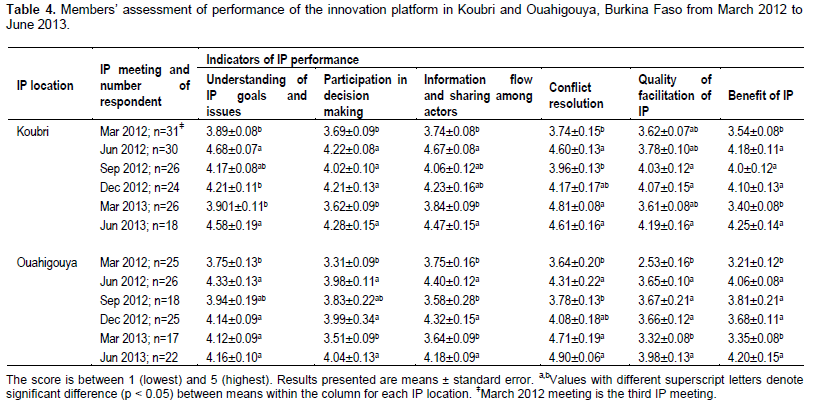
The results of the regression analyses of the six parameters of IP functioning (response variables) on the independent variables (IP location (Koubri and Ouahigouya), period of IP meeting, actors’ group and gender) are presented in the equations for the average scores below for each indicator (only variables that are significant at p<0.05 are included; means ± standard error). These regression results should be interpreted with caution as they were based on perception of the IP members and the R2 is generally low for all the indicators. In the equations, the IP location, meeting dates, actors’ group and gender are abbreviated as follows: L1 = IP location Koubri; L2 = IP location Ouahigouya; IP3 = Meeting in March 2012; IP4 = Meeting in June 2012; IP5 = Meeting in September 2012; IP6 = Meeting in December 2012; IP7 = Meeting in March 2013; IP8 = Meeting in June 2013; Actor2 = Producer; Actor3 = Trader; Actor4 = Processor; Actor 7 = Credit agency; Actor 8 = Technical services; Actor 10 = Researcher; Actor11 = Development practitioners; Male = Gender1; Female = Gender2.
1. Understanding and relevance of IP issues: 4.18±0.07 + 0.20±0.10 IP8 - 0.36±0.13 Actor8 (R2 = 0.15)
2. Participation in decision making: 4.01±0.06 - 0.20±0.06 L2 + 0.29±0.09 IP6 + 0.36±0.10 IP8 - 0.24±0.11 Actor3 - 0.30±0.12 Actor8 - 0.21±0.08 Gender2 (R2 = 0.43)
3. Information flow and sharing: 4.06±0.05 + 0.29±0.11 IP6 + 0.29±0.11 IP8 - 0.66±0.14 Actor8 (R2 = 0.41)
4. Conflict resolution: 4.33±0.05 + 0.51±0.14 IP8 - 0.69±0.31 Actor7 - 0.68±0.17 Actor8 (R2 = 0.35)
5. Facilitation of IP: 3.80±0.06 - 0.37±0.07 L2 + 0.24±0.10 IP6 + 0.51±0.11 IP8 - 0.38±0.11 Actor3 (R2 = 0.46)
6. Perceived benefit: 3.86±0.05 - 0.17±0.07 L2 + 0.48±0.10 IP8 - 0.28±0.11 Actor3 + 0.47±0.20 Actor10 (R2 = 0.41)
From the equations, gender only had significant effect in the regression equation for participation in decision making where women gave lower score than men. The results confirm again that the IP meetings were dominated by men in terms of participation in decision making which could be attributed to socio-cultural factors as well as the high proportion of male at the meetings. To ensure gender equity in participation and contribution in decision making in the IPs, it is necessary to involve more women than the present situation by addressing issues of interest to them (Klerkx et al., 2010; Nederlof et al., 2011; Adekunle et al., 2012). Compared to IP in Koubri, the members of IP in Ouahigouya gave lower score to participation in decision making, quality of facilitation of IPs and perceived benefit of the IP. This may be attributed to long exposure to development projects by people in Ouahigouya compared to Koubri which might have made the IP members in this site to be more critical in their assessment of the IP activities. In both IP locations, the technical services group gave lower score to the six indicators compared to the producer’s group. This shows that the technical services are more critical of the performance of the IP than the producers. This was expected as most of the IP activities were targeted at the crop and livestock producers. To engage the technical services in the IPs and sustain their interest, it is necessary to include activities that are of interest to them for example training in their technical domains or remunerate them for services provided to producers in the IP. The results also showed that the researchers gave higher score for the perceived benefit of the IPs than the producers. Since this group and the development practitioners were responsible for the establishment of the IPs, they might have strong justification to show that the IP is beneficial to all the actors. The scores for the six indicators for the IP meeting in June 2013 were significantly higher than the scores for the meeting in March 2012 which again confirms that IP tends to perform better with more time to carry out its activities. However, it needs to be stated that the scores seem to fluctuate and the increase over time was not linear.
Achievements of the innovation platforms according to the producers
To further assess the perceived benefits of IP by the producer groups (crop farmers and livestock keepers), we presented their scores of different achievements of IP in the two study sites in Figure 5a and b. According to the crop farmers, the highly rated (with average score of between 8 to 10) perceived benefits of IP in Koubri were access to inputs, access to market, improved soil and water management, better interaction between IP actors, access to information and increased production (crop yields) while the livestock keepers rated highly capacity development, access to inputs, better interaction between IP actors, access to information and increased production as the perceived benefits (Figure 5a). Generally, the crop farmers and livestock keepers in both sites scored high on most issues, except for access to credit (average scores of 2 and 3 for crop farmers and livestock keepers, respectively) due to the persistent problem of accessing credit from the micro-finance NGOs at the study sites despite the repeated attempts of the IP to engage with the NGOs. Generally, the crop farmers tended to rate a bit more highly the perceived benefits of the IP in Koubri than the livestock keepers though the overall trend for both is similar. This trend could be partly attributed to low representation of the livestock keepers (agro-pastoralists) as they are recent immigrants in Koubri. Besides, the IP meeting agenda in Koubri tilted heavily in favor of the crop farmers who dominated the meetings. The results for the IP in Ouahigouya (Figure 5b) were the opposite of those of Koubri as the livestock keepers rated more highly the perceived benefits of IP in Ouahigouya than the crop farmers. The livestock keepers scored access to inputs, interaction between actors, capacity development, and access to information very highly (average scores of ten out of ten) whereas crop farmers only scored access to information very highly. Again, access to credit had the lowest score of about five out ten for both crop farmers and livestock keepers in Ouahigouya as it was in Koubri. The livestock keepers in Ouahigouya also rated quite low access to market based on their experience of low prices for their animals. According to them, the intermediaries who come to the villages to buy live animals often offered low prices and were the ones making most profit. To address this problem, training was organized on group marketing to strengthen their negotiating power but this faced the problems of trust among the livestock keepers and the inability to wait for buyers with good prices as they are often compelled to sell their animals to meet urgent needs. Generally, these results suggest that IP is perceived as successful by the producers except for access to credit and that it is able to address technical, organizational and institutional constraints. Besides, the results support the general view that benefits of platform participation should be visible as incentive for active engagement of the members. Adekunle et al. (2012) observed that platforms centred on value chain development have inherent financial benefits which may motivate participation by the actors but the incentives for participation is less visible in platforms on natural resource management as concrete benefits tend to be on a long-term.
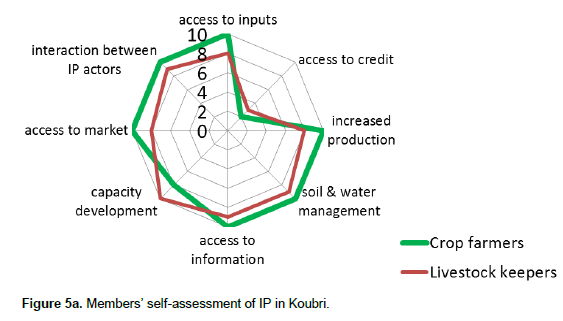
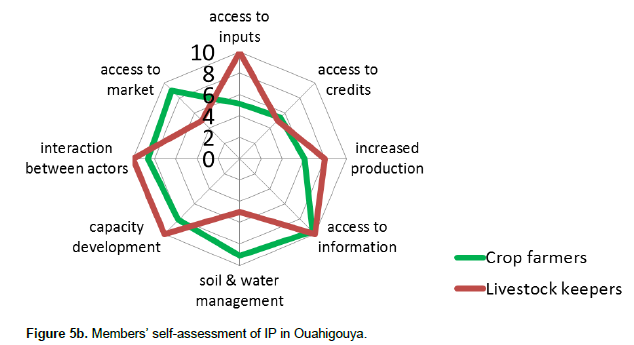
Implications of findings from the study for IP approach
From the results of this study, the key emerging issues regarding IP approach for operationalization of Integrated Agricultural Research for Development are:
1. For agricultural research and development, it is important that stakeholders themselves perceive the IP as beneficial. Our results suggest that this seems to be the case even though the short term benefits such as capacity building to increase the skills and knowledge of the IP members seem more obvious than long-term outcomes such as improved crop and livestock productivity.
2. Key factors identified through this study for the performance of IPs were quality of facilitation, location, the period (season) of IP meeting and gender. These need to be taken into account when designing and establishing IPs. Facilitation is critical to the IP process and functioning as has been argued by several others (Klerkx et al., 2010; Adekunle et al., 2012; Schut et al., 2015).
3. IPs need time to mature and to become fully functional in order to deliver concrete outcomes, which implies that the IP process needs to go along with short terms benefits such as a training/capacity building.
4. IPs tends to focus initially on production as shown by our results on activities carried out by the IP members but this tends to change over time whereby the platforms address more institutional issues. To achieve this, it is important that the facilitators keep the process focused on issues of shared/common interest. For example, this could be done by establishing farmer producer groups alongside IPs so that IP can focus more on institutional issues instead of issues mainly related to production.
5. There is a risk that IPs will reinforce the current Agricultural Research for Development regime (Schut et al., 2015). However, there are indications in the study that institutional changes did occur, which will need continuous attention and willingness from stakeholders from the start not only to support and help others, but also to challenge and be critical of their own practices.
6. This study relies heavily on a self-assessment of participants. There may be a risk that this may not necessarily comply with what happened ‘in reality’. However, we would argue that it is in the first place the stakeholders themselves who need to see the added value of the IP and be willing to invest in the process.
Therefore, their perceptions provide an important element in assessing IPs.
7. Simple participatory monitoring and evaluation can provide useful information to steer and adapt/correct the IP process if necessary. The tools we used in this study are very simple and could be applied and documented by the facilitation staff themselves even though they often do not see M&E as being their task, which poses a challenge to the systematic documentation of IP processes and performance (Swaans et al., 2013).
Assessment of the functioning of two IPs in Koubri and Ouahigouya, Burkina Faso shows that innovation systems approach is relevant and important for effective linkages between different actors for better access to technical and financial services, and for building capacity of the members. The performance of the IPs seems to improve with the lifespan which underscores the necessity of long-term plan for the establishment of IPs. To ensure effective participation of different actors at the IP, issues being addressed should be of common interest and should be clearly articulated. Therefore, there should be concerted efforts by the facilitators of the IP to engage all the actors and avoid domination by any group. Facilitation is critical to IP performance as shown by the results of the members’ assessment. In addition, a systematic monitoring of IP functioning is indispensable for assessment of its performance and output, and this should be accorded the right place in the running of the IPs.
The authors declare that they do not have conflict of interests
This research was carried out through the CGIAR Challenge Program on Water and Food (CPWF) in the Volta Basin with funding from the European Commission (EC) and technical support from the International Fund for Agricultural Development (IFAD).
REFERENCES
|
Adekunle AA, Ellis-Jones J, Ajibefun I, Nyikal RA, Bangali S, Fatunbi O, Ange, A (2012). Agricultural Innovation in Sub-Saharan Africa: Experiences from Multiple-Stakeholder Approaches. Forum for Agricultural Research in Africa (FARA), Accra, Ghana.
|
|
|
|
Amankwah K, Klerkx L, Oosting SJ, Sakyi-Dawson O, van der Zijpp AJ, Millar D (2012). Diagnosing constraints to market participation of small ruminant producers in northern Ghana: An innovation systems analysis. NJAS - Wageningen J. Life Sci. 60-63:37-47.
Crossref
|
|
|
|
Boogaard B, Schut M, Klerkx L, Leeuwis C, Duncan A, Cullen B (2013). Critical issues for reflection when designing and implementing Research for Development in Innovation Platforms. Report for the CGIAR Research Program on Integrated Systems for the Humid Tropics. Knowledge, Technology & Innovation Group (KTI), Wageningen University & Research centre, the Netherlands.
|
|
|
|
Cadilhon J (2013). A conceptual framework to evaluate the impact of innovation platforms on agrifood value chains development. Paper presented at the 138th European Association of Agricultural Economists Seminar on Pro-poor Innovations in Food Supply Chains, Ghent Belgium September 11-3, 2013.
|
|
|
|
Cullen B, Tucker J, Snyder K, Lema Z, Duncan A (2014). An analysis of power dynamics within innovation platforms for natural resource management. Innov. Dev. 4(2):259-275.
Crossref
|
|
|
|
Douxchamps S, Ayantunde A, Barron J (2014). Taking stock of forty years of agricultural water management interventions in smallholder systems of Burkina Faso. Water Res. Rural Dev. 3:1-13
Crossref
|
|
|
|
Engel PGH (1995). Facilitating Innovation: an Action-oriented Approach and Participatory Methodology to Improve Innovative Social Practice in Agriculture. Wageningen Univer. Wageningen, The Netherlands.
|
|
|
|
Hounkonnou D, Kossou D, Kuyper TW, Leeuwis C, Nederlof ES, Röling N, Sakyi-Dawson O, Traoré M, van Huis A (2012). An innovation systems approach to institutional change: Smallholder development in West Africa. Agric. Syst. 108:74-83.
Crossref
|
|
|
|
Kilelu CW, Klerkx L, Leeuwis C (2013). Unravelling the role of innovation platforms in supporting co-evolution of innovation: Contributions and tensions in a smallholder dairy development programme. Agric. Syst. 118:65-77.
Crossref
|
|
|
|
Klerkx L, Aarts N, Leeuwis C (2010). Adaptive management in agricultural innovation systems: The interactions between innovation networks and their environment. Agric. Syst. 103:390-400.
Crossref
|
|
|
|
Klerkx L, van Mielo B, Leeuwis C (2012). Evolution of systems approaches to agricultural innovation: Concepts, analysis and interventions. In: Farming systems research into the 21st century. The new dynamic, ed. I. Darnhofer, D. Gibbon, and B. Dedieu, Dordrecht, The Netherlands: Springer. pp. 457-483.
Crossref
|
|
|
|
Leeuwis C, van den Ban A (2004). Communication for Rural Innovation: Rethinking Agricultural Extension. Oxford: Blackwell Science.
Crossref
|
|
|
|
Lundvall BÅ (2011). Notes on Innovation Systems and Economic Development. Innov. Dev. 1:25-38.
Crossref
|
|
|
|
Nederlof S, Wongtschowski M, Van der Lee F (eds.) (2011). Putting heads together: agricultural innovation platforms in practice. KIT publishers: Amsterdam, the Netherlands. Bulletin P. 396.
|
|
|
|
Pali P, Swaans K (2013). Guidelines for innovation platforms: Facilitation, monitoring and evaluation. ILRI Manual 8. Nairobi, Kenya: ILRI.
|
|
|
|
Pretty J, Toulmin C, Williams S (2011). Sustainable intensification in African agriculture. Int. J Agric. Sustain. 9(1):5-24.
Crossref
|
|
|
|
van Rooyen A, Homann-Kee Tui S (2009). Promoting Goat Market and Technology Development in Semiarid Zimbabwe for Food Security and Income Growth. Trop. Subtrop. Agroecosystems 11(1):1–5.
|
|
|
|
Schut M, Klerkxl L, Sartas M, Lamers D, Campbell MMC, Ogbonna I, Kaushik P, Atta-Krah K, Leeuwis C (2015). Innovation platforms: Experiences with their institutional embedding in agricultural research for development. Exp. Agric. 25 p.
Crossref
|
|
|
|
Statistical Analysis System Institute (1987). SAS/STAT for Personal Computers, SAS Institute, Inc., Cary, NC.
|
|
|
|
Swaans K, Cullen B, van Rooyen A, Adekunle A, Ngwenya H, Lemma Z, Nederlof S (2013). Dealing with critical challenges in African innovation platforms: lessons for facilitation. Knowl. Manage. Dev. J. 9:116-135.
|
|
|
|
Swaans K, Boogaard B, Bendapudi R, Taye H, Hendrickx S, Klerkx L (2014). Operationalizing inclusive innovation: lessons from innovation platforms in livestock value chains in India and Mozambique. Innov. Dev. 4(2):239-257.
Crossref
|